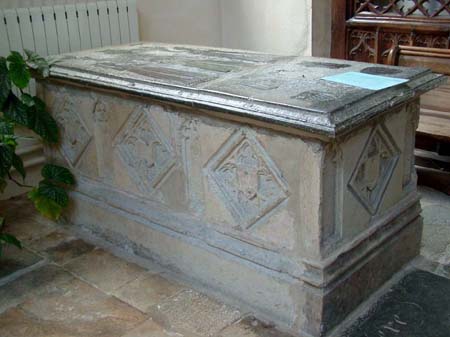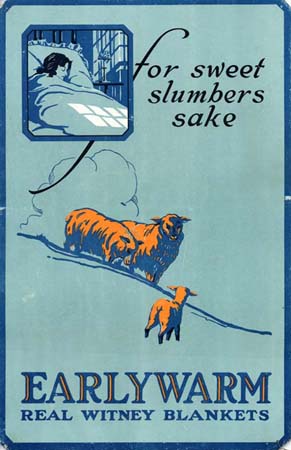

Why Witney?The Witney area has been linked to the wool and cloth making trade for over 900 years, going back to at least the 12th century. Many reasons have been put forward as to why a blanket trade centred on Witney developed and why it was so successful for so long: below are some of the possible explanations. Why did a wool industry develop in Witney? Witney was also blessed because it lies close to the Cotswold Hills, whose dry, open pastures provide lots of excellent land for the farming of these sheep. There is evidence that wool production was widespread in the county from a very early period, so you could ask why not Witney? The River Windrush supplied the large volumes of water necessary for many cloth-making processes such as dyeing and fulling. Importantly, the water would have been relatively clean because Witney is the first town on the river. The Windrush also provided a good millstream to power the fulling mills where woven cloth was cleaned and processed. The Bishops of Winchester, who developed Witney, encouraged the growth of the wool trade in the town. They had vast estates of land on which they farmed many flocks of sheep, and their manor house (the 'Bishop's Palace') was a centre for the collection of wool from surrounding areas. They also built three fulling mills in the area by as early as 1223 [1]. What helped Witney's wool and blanket trade to grow? Like all trades, the wool and cloth industry in Witney suffered its share of depressions and hard times over the years, but the town established a growing reputation for cloth production as early as the 15th century. By the 17th century it was famed specifically for making high quality blanketing material and blankets.  The seal matrix (stamp) of the Witney Blanket Weavers' Company. The word 'Wavers' is the Witney dialect pronunciation of weavers. Geography and transport links were important factors. Witney was only about 70 miles from each of the major ports of London, Bristol and Southampton, all of which could be reached over good roads; these roads were improved by new bridges in the 15th century [2]. Most wool for export in the Middle Ages, especially the best quality which came from the Cotswolds, went via London to Calais so that the State could collect duty on it and regulate the flow of these valuable goods, and London was a major market in its own right. The transformation of blanket making from a cottage industry into a factory-based operation during the 19th century was key to Witney's success. Having already gained a strong reputation and established sound trading links, Witney was able to emerge as a competitive force in the new industrialised Britain. Blanket making was now in the control of a small handful of people who had enough entrepreneurial spirit, business sense and luck to develop their companies from small family-run concerns to large mills employing hundreds of people. In the 19th century, competition from Yorkshire also spurred Witney manufacturers to make important innovations, such as changing products to meet new demands, installing new machinery in their mills and campaigning for a railway to be built to the town so that the coal for running steam engines could be brought in and blankets sent out more cheaply. Why did Witney specialise in broadcloth and blanket making? What enabled the industry to last for over 300 years? The working environment was important: Witney had a ready local labour force with a lot of expertise in the business and good working conditions attracted people in to work from other areas. The family-run businesses in Witney all seem to have maintained a good reputation for the caring and respectful treatment of their workers. Witney blanket makers developed a good export market, particularly in North America and Africa. A strong and long lasting trade was maintained with the Hudson Bay Company, which traded dyed blankets with Native Americans for beaver skins. Dr Plot mentions improvements in dye fixing, invented by a Witney inhabitant, that may have been significant in helping establish this trade [6]. The Witney manufacturers also regularly supplied orders to other big customers such as the army and navy, especially at times of war. Witney blanket makers had an informal but strong system of mutual support, especially before industrialisation was fully developed [7]. The different makers shared orders, storage and transport when necessary. When weaving was carried out on handlooms, this gave them a good degree of competitive flexibility and ensured that they could meet orders and deadlines, even when the individual firms might not have had the capacity to do so by themselves. Finally, the Witney blanket industry proved itself to be adaptable throughout its history. Although in the early 19th century the blanket makers were slow to adopt new technology compared with other areas such as Yorkshire, they eventually came to bring many innovations to their industry, right down to Fiberweaving in the 1960s. This allowed them to compete successfully with rival producers throughout Britain and the World.
|
|
| References [1] Townley 2004: p76 [2] Townley 2004: p76 [3] Plot 1677: p278-280 [4] Plot 1677: p278-280 [5] Plummer and Early 1969: p107 [6] Plot 1677: p278-280 [7] Plummer and Early 1969: p68 |
|




